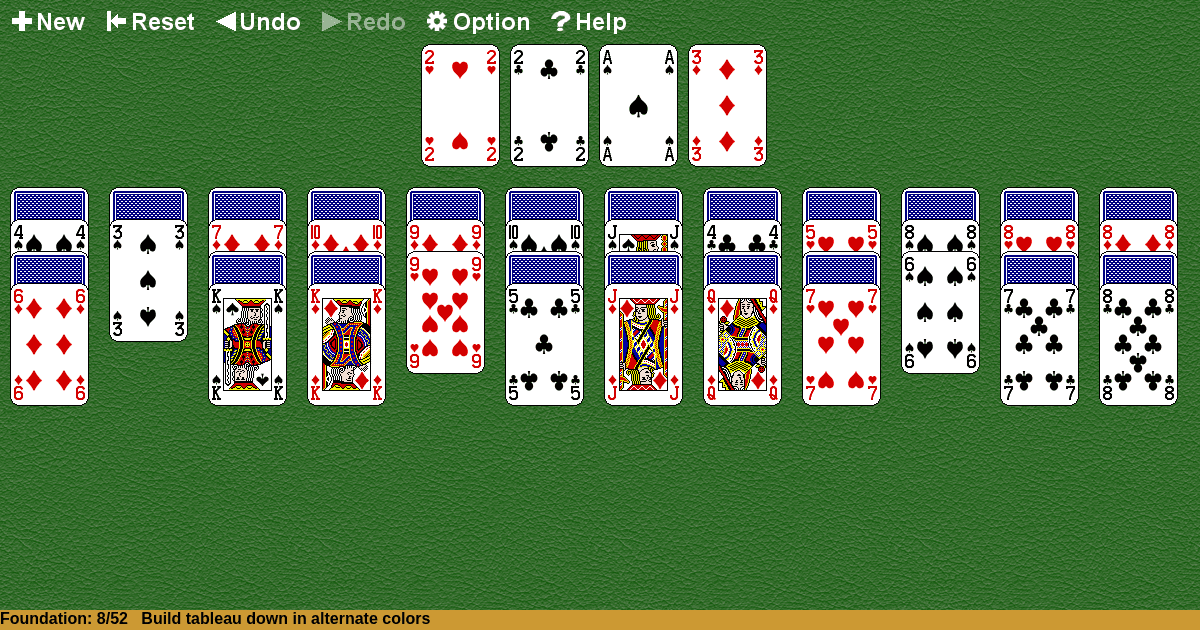Stewart
Home |
How to play |
FAQ |
About
How to play Stewart?
Game Objective:
The primary goal in Stewart Solitaire is to move all cards from the tableau to the foundation piles, building each foundation by suit in ascending order from Ace through King.
Setup & Layout:
- Use a standard 52-card deck.
- Tableau: Arrange twelve tableau piles, each with four cards splayed downward.
- In each pile, odd-numbered cards (positions 1 and 3 from the top) are dealt face-down.
- Even-numbered cards (positions 2 and 4 from the top) are dealt face-up.
- There are no separate stock, reserve, or cell areas; all cards are initially distributed among the tableau piles.
Stewart Solitaire Rules:
- Card Movement: Cards may be moved between tableau piles according to specific building rules.
- Building Sequences: You may build tableau piles down in suit (i.e., place a card one rank lower and of the same suit onto another card).
- Example: Place the 6♠ on the 7♠.
- Moving Cards: Only the top face-up card of each tableau pile is available for play.
- If a face-down card becomes the top card of a pile (after the face-up card is moved), it is turned face-up and becomes available for play.
- Foundations: When an Ace becomes available, move it to start a foundation pile for its suit. Foundations are built up by suit from Ace to King.
- Sequences: Only single cards may be moved; sequences cannot be moved together.
Gameplay:
- On each turn, the player may:
- Move a face-up card from the tableau onto another tableau pile, following the building rules (down in suit).
- Move a face-up Ace to start a foundation pile.
- Build on foundation piles by moving the next required card of the same suit and ascending rank.
- After moving a face-up card, immediately turn over any newly exposed face-down card in that pile to make it available.
- No Stock or Redeal: There is no stock pile; all cards are in play from the start.
- If no legal moves are available, the game ends.
Winning & Losing Conditions:
- Win: The game is won when all cards have been moved to the foundation piles, each built up by suit from Ace to King.
- Lose: The game is lost (unwinnable) if no further legal moves can be made and not all cards have been transferred to the foundations.
Special Rules & Edge Cases:
- Empty Tableau Piles: If a tableau pile becomes empty, it cannot be filled; empty spaces remain vacant for the rest of the game.
- Exposing Cards: Whenever a face-down card is exposed at the top of a pile, it must be turned face-up immediately.
- No Sequence Moves: Only single cards may be moved between tableau piles; you cannot move multiple cards as a sequence.
- No Stock, Reserve, or Redeal: There is no way to introduce new cards into play after the initial deal; all gameplay occurs within the tableau and foundations.
Key Terms Defined:
- Tableau: The main play area consisting of twelve piles where cards are initially dealt and manipulated.
- Foundation: Piles where cards are built up by suit from Ace to King, representing progress toward victory.
This guide covers all core mechanics and edge cases for Stewart Solitaire, ensuring precise understanding of its unique ruleset.

Solitaire Collection
About Stewart
Rate (Stewart)
4.7 / 5
1,916 votes



























































